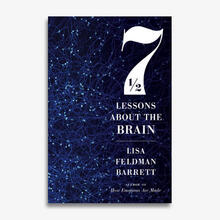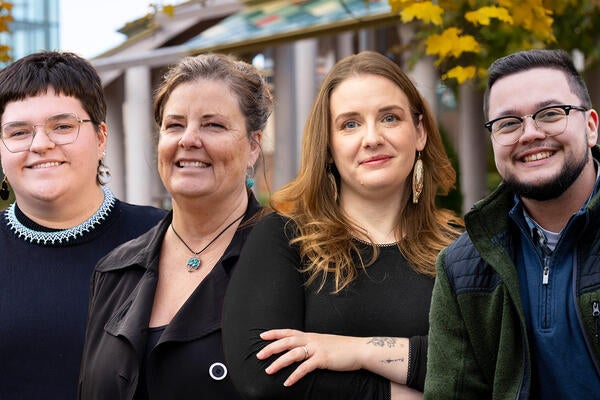
Mind Boggling
Meet the Waterloo alumnus and Guggenheim Fellow changing how we understand emotion and the brain

Meet the Waterloo alumnus and Guggenheim Fellow changing how we understand emotion and the brain
By Megan Vander Woude Office of AdvancementAs a clinical psychology student at Waterloo, Lisa Feldman Barrett (PhD ’92) made a discovery that would completely transform our understanding of emotion. Over the last 25 years, her research has uncovered how little we know about emotion and the mind.
 To begin her research, Lisa did what many graduate students do: she tried to replicate findings from published scientific papers. She hoped to replicate studies about the self, then build on them to create her own program of research. But she never managed to do it. “I actually got to the point where I thought about leaving graduate school,” she says. “I lost confidence because I kept failing to replicate findings that had been published.”
To begin her research, Lisa did what many graduate students do: she tried to replicate findings from published scientific papers. She hoped to replicate studies about the self, then build on them to create her own program of research. But she never managed to do it. “I actually got to the point where I thought about leaving graduate school,” she says. “I lost confidence because I kept failing to replicate findings that had been published.”
After a failed dissertation proposal, Lisa went back to her previous studies to find a new focus for her research. When she looked over her work, she found something interesting with the way people reported on their emotions.
“In these studies, I had to determine whether people felt anxious or depressed,” explains Lisa. “But people weren’t distinguishing between anxiety and depression. They were either reporting that they felt bad or they felt good. In order to replicate the study, people had to distinguish what they were feeling in a more granular way.”
Lisa thought there was a straightforward solution: she would measure emotion based on physical changes, such as facial expressions, increases in heartrate or sweating. That decision led Lisa to discoveries, ultimately challenging common beliefs we’ve held about emotion for more than 2000 years.
Lisa poured over research on facial muscle movements and bodily changes that occur during episodes of emotion. At the time, psychologists accepted the idea that anger, sadness, fear and several other categories of emotion are shown with unique expressions and controlled by specific areas in the brain. But when Lisa dove into the published evidence, she didn’t come to the same conclusion.
“There’s tremendous variability in how people move their faces during emotional states,” explains Barrett. “People sometimes scowl in anger, but they also laugh in anger, cry in anger, frown in anger…. And they scowl when they aren’t angry – like when they’re concentrating really hard, when they’re confused, or when they have gas. This sort of variation occurs in bodily changes as well. Blood pressure can go up or down during anger, and during other emotional states. On top of that, hundreds of studies show that an emotion cannot be traced any specific spot in the brain.”
These findings became the basis for her entire career as a scientist.
“Many humans manage to have these distinct emotional states. How are such emotions made? And how do we perceive emotion in each other as easily as we read words on a page?” asks Lisa. “It’s a very interesting question, and it turns out to be a question that really overturned most of the dogma in the findings of emotion.”
Over the years, Lisa has uncovered new details about emotions and how they are formed by the brain. Many of her findings have transformed the way we understand emotion and the mind in general.
LISA FELDMAN BARRETT, PhD '92'
If you want to be creative and innovative, you have to learn how to fail fast and big, and then push forward to discover something new. You need a lot of support.... That’s something that the Waterloo psychology department did really well. It’s a pretty special place.
As it turns out, emotions are much more complicated and dynamic than we thought. Lisa’s research tells us that our brains construct emotions from scratch as we experience them, and that we have more control over our emotions than we might think.
“It definitely overturned the scientific understanding of how we feel,” says Lisa. “But that’s small potatoes, because it’s actually overturning our entire understanding of how a brain and body create a mind, and how a human mind works.”
And other scientists agree with her. Lisa’s collaborative and innovative approach has gathered prestigious attention over the years. In 2007, she received the National Institutes of Health Director’s Pioneer Award, a title for scientists with unusual creativity and innovation. Since its inception, only two psychologists have received the award.
 Most recently, she was awarded a Guggenheim Fellowship, which supported her new popular science book Seven and a Half Lessons About the Brain. The book presents scientific insights about how the human brain works and considers what they reveal about human nature. This is Lisa’s second popular science book.
Most recently, she was awarded a Guggenheim Fellowship, which supported her new popular science book Seven and a Half Lessons About the Brain. The book presents scientific insights about how the human brain works and considers what they reveal about human nature. This is Lisa’s second popular science book.
In her first book, How Emotions are Made: The Secret Life of the Brain, Lisa explores findings and current understanding of how our brains construct emotion.
After years of research, Lisa still credits her time at Waterloo as a key building block for her success.
“If you want to be creative and innovative, you have to learn how to fail fast and big, and then push forward to discover something new,” she says. “And you need a lot of support to do this and cultivate transformative science. That’s something that the Waterloo psychology department did really well. It’s a pretty special place.”

Read more
From optometry and pharmacy to public health and therapeutics, Waterloo alumni are powering Canada’s health care sector

Read more
A winter holiday message from President Vivek Goel

Read more
Researchers awarded funding to investigate ecology, climate change, repatriation, health and well-being through cultural and historical lens
The University of Waterloo acknowledges that much of our work takes place on the traditional territory of the Neutral, Anishinaabeg, and Haudenosaunee peoples. Our main campus is situated on the Haldimand Tract, the land granted to the Six Nations that includes six miles on each side of the Grand River. Our active work toward reconciliation takes place across our campuses through research, learning, teaching, and community building, and is co-ordinated within the Office of Indigenous Relations.